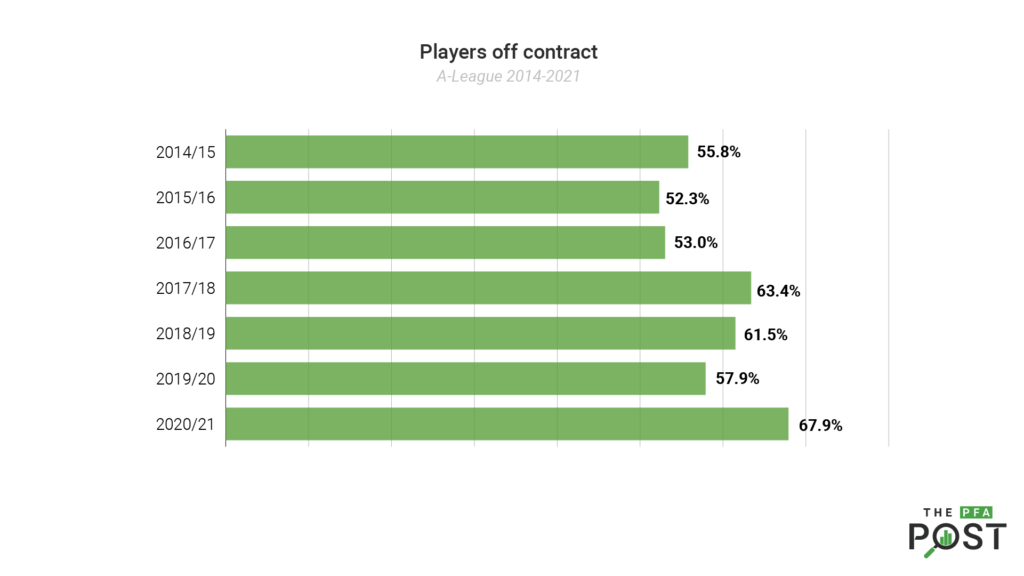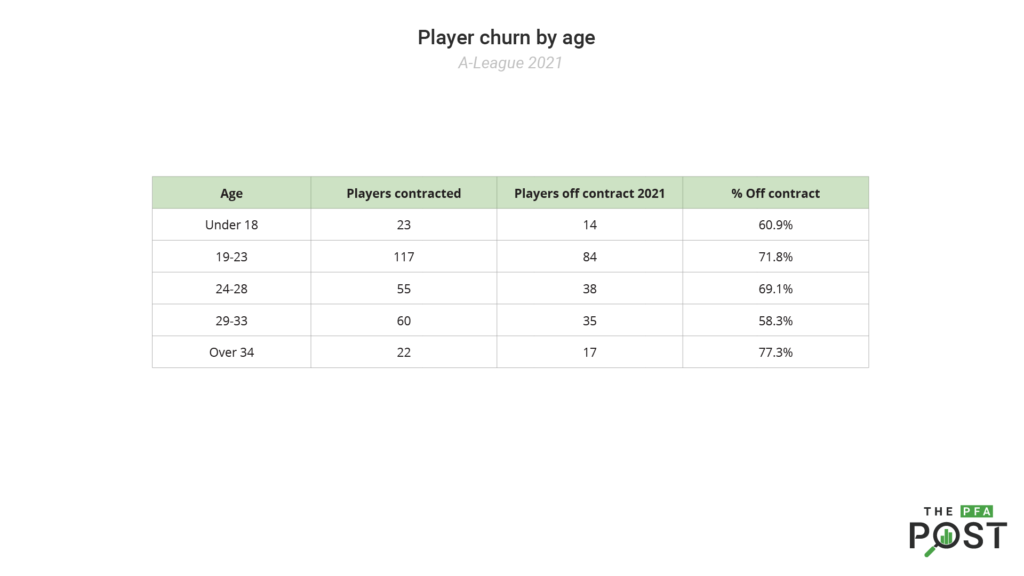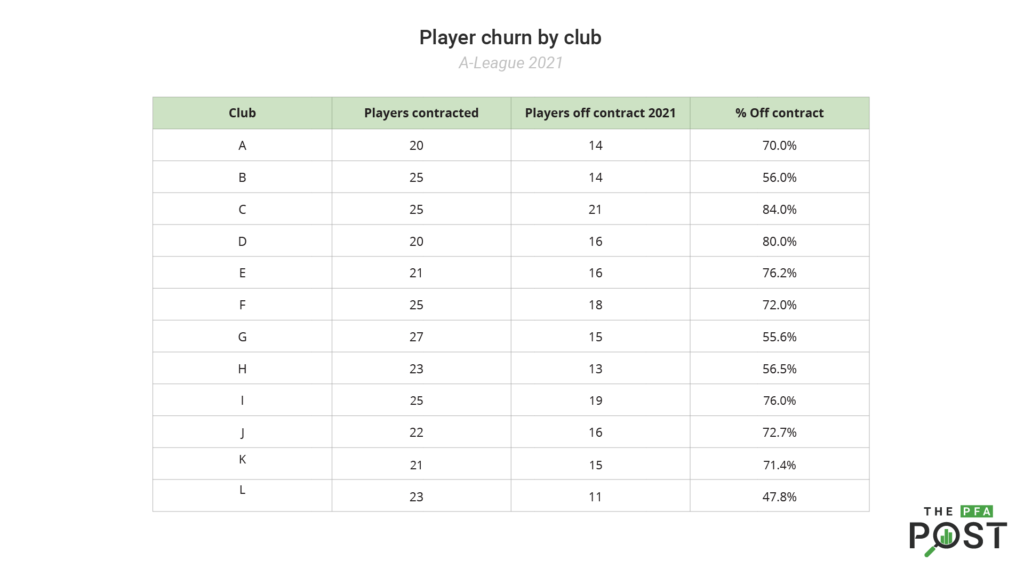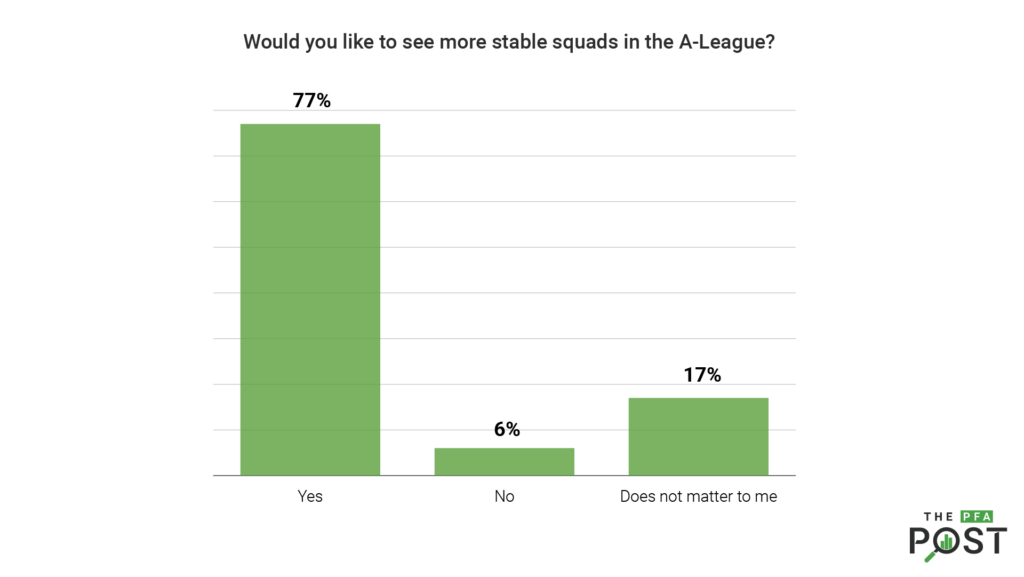The A-League’s labour market is as volatile as ever for professional footballers with a record 68% of players coming off contract at the conclusion of the current season, the latest PFA Post reveals.
Over two thirds of the 277 contracted A-League players will be out of contract come June 30 this year, representing an equivalent of nearly eight players out of every starting XI being in the final year (or only year) of their current contract.
The PFA’s research confirms the trend of high levels of player ‘churn’ remains a systematic result of the current regulations within the A-League, including the salary cap, with the findings revealing:
- 181 of 277 contracted players will be out of contract at the conclusion of the 2020/21 season, which represents 67.87% of the workforce
- Only 3% of A-League players (10 players) are contracted beyond the 2021/2022 season
- 60% of players under 18 and 72% of players aged between 19 and 23 are off contract at the end of the current season, harming A-League clubs’ ability to adequately develop and create value in their young talent
The PFA Post adds to a wealth of evidence the PFA has developed over several years that demonstrates how all of the League’s stakeholders would benefit from more stable rosters and how players, clubs and fans have suffered the harmful impacts of high amounts of player churn, including;
- Clubs are unable to build value in their playing squads due to a propensity to contract players short-term;
- Sporting success is undermined both domestically and in Asia due to extreme player churn (as outlined in Issue 2 of The PFA Post);
- Fan disengagement due to an inability to build lasting connections with a club’s players; and
- The game’s scarce resources being diverted to constant negotiations, salary cap management and relocation payments despite no net increase in playing quality.
In order to adequately address the current symptoms of a failing labour market model, the PFA will continue to advocate for reform to build a model that is fit for purpose and allows for the sport to build value in its players, clubs and leagues.
🔄 Player Churn: 2014-2021
Following examination of all 12 clubs’ playing rosters, the current number of players coming off contract is the highest recorded in the A-League since PFA research on contracting commenced in 2014. Over the past seven seasons, more than half of the A-League’s players are coming off contract at the start of each season, with the 2020/21 season the highest on record at 67.87%.

While 188 players are coming off contract, 28.5% of players have either one year beyond this season (79 players) and 3% (10 players) have a contract until 2023. No player in the A-League has a contract beyond that period.
🔄 Player Churn: Age Groups
While long-term contracting not only provides players with job security and clarity over their careers, clubs can also benefit from long-term contracting practices. The longer players remain at one club, the more opportunity they have to develop as a player and the more chance a club has to cultivate that players’ talent.

Unfortunately, the majority of players most likely to deliver dividends for clubs through the international transfer system are coming out of contract. For example, 60% of players under the age of 18 and 72% of players aged between 19 and 23 are off contract at the end of the current season.
Within these two cohorts (players aged <18 to 23), several players will enter the ‘shop window’ if the Tokyo Olympics proceed in 2021, where Australia’s finest youth talent will showcase their skill on a global stage. Due to the current contracting practices, those players attracted overseas are likely to leave Australian shores for free, with 78% of Joeys, 54.8% of Young Socceroos and 55.2% Olyroos based at A-League clubs coming off contract.
🔄 Player Churn: By Club
Across the 12 current A-League clubs, player churn remains a significant issue for football departments to build stable squads to deliver success, with even the lowest percentage of off-contract players at a club close to half (47.83%) a 23-player squad.

Eight of the A-League’s 12 clubs have 70% or higher of their players coming off contract, with the highest being 21 players of a squad of 25 (84%). When deeper analysis is conducted on squad composition – and considers foreign players are more transient than Australian players – two clubs have 85% and 90% of their Australian players coming off contract.
🌍 Rest of the World
As demonstrated in Issue 2 of the PFA Post, squad churn directly affects each teams’ ability to build a squad that not only delivers success across the season, but also fails to build a meaningful connection with fans and build value that can be realised in the international transfer market.
The PFA is not the only organisation in global football that has demonstrated the impact of player churn on football success. The CIES Football Observatory’s ‘The importance of squad stability: evidence from European football’ illustrated the ‘value of long-term planning for football clubs’:
The study reveals the correlation between squad stability and success. The best performing teams have much more stable squads than lesser competitive ones. Between 2009 and 2017, big-5 league champions had on average only about one in four new players as squad members. This proportion can be considered as an optimal balance to achieve success.
In Issue #2 of The PFA Post, research demonstrated how the A-League’s broken contracting model and current regulations has led to an erosion in competitive balance, with Sydney FC – which has had the most stable squad across the previous five seasons – continue to deliver high levels of sporting success due to low levels of squad turnover.
😕 Career Uncertainty
There is also a human story behind the data. Each of the 188 players off contract have to deal with uncertainty beyond the next six months. At the current rates of churn, players have to put forward planning on hold, support networks are left behind, families are uprooted, partners’ lives are disrupted, and off-field development is potentially stunted.
This uncertainty undermines the ability of A-League to attract and retain talent. This is illustrated by the recent findings of the 2019/20 PFA A-League Report which found that:
- just 44% of players indicated their preference was to remain in the A-League; and
- only 33.5% of players were either extremely or very confident about the future direction of their careers.
With Australia dependent on a relatively small pool of professional players to ensure our international competitiveness, the extreme churn reduces the attractiveness of the career path with players unsure whether they will have a job beyond this season, which side of Australia they will be living on (or will they move to New Zealand?), or whether their salary will radically change. This instability has flow-on effects to all aspects of players’ lives and those of their immediate families.
🏟 Impact on Fan Engagement
In 2018, the PFA surveyed fans on a range of issues relating to their support for the A-League. When asked whether they would like to see more stable clubs, 77% of respondents said ‘yes’. There is a clear advantage of having stable squads that deliver sporting success and success naturally produces fan connection and engagement.

However, respondents also indicated success was not the only barometer for their ongoing support, with player retention often overlooked as a rationale to ensure fans and members’ ongoing attachment.
🔄 Player Churn: Conclusion
The current A-League regulations, which are applied to clubs in the pursuit of legitimate objectives – those being competitive balance and financial sustainability – are contributing to a range of unintended consequences, as illustrated above.
In an attempt to address the impact of the salary cap on short-term contracting, a range of exemptions, such as loyalty, homegrown and marquee player allowances have been collectively bargained in good faith between the PFA, Football Australia and the clubs. Despite these intentions and the significant take up at some clubs, they have been unable to support greater contractual stability.
Following the separation of the professional leagues from Football Australia and the expiration of the current collective agreements at the conclusion of the current season, the game has an opportunity to build a fit for purpose model in partnership with the clubs.
In doing so, it is critical that the league addresses key strategic matters first, such as whether the A-League is closed or open, what the season window looks like, the generation and distribution of the game’s revenues and the optimal league size.
Once these matters are addressed, all stakeholders can then build effective labour market regulations that work in harmony with the legitimate objectives and the strategic priorities. Attempts to build our model solely around labour market regulations will be counterproductive and will not provide the game with the opportunity to build a coherent identity.
About the PFA Post
In line with the PFA’s commitment to providing policy leadership to ensure Australian football is the best governed football nation in the world, is internationally competitive on and off the field and is a central part of Australian culture, ‘The PFA Post’ analyses issues impacting Australian football.







